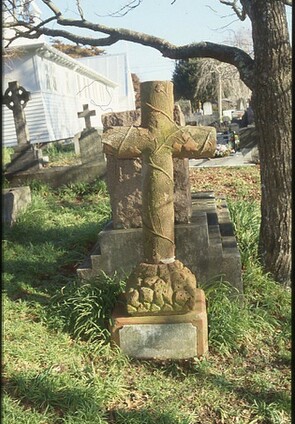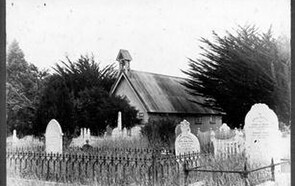The Churchyard
People were being buried in the churchyard as soon as the land was consecrated in 1865 and even before, possibly as early as 1862. The earliest identifiable grave is that of Richard Barton, founding father of both church and district, who died in August 1866. A poignant reminder of pioneer life is the nearby grave of Matilda Symons and her 8-year-old son James, who drowned together in the Hutt River in 1869. Altogether over a thousand people are buried here, and each headstone tells a tale, such as the (now broken) pipe cross of 19-year-old Ambrose Thomas Preston. Ambrose was 'accidentally shot' by a companion while pig-shooting on the Haywards hills in 1906; his death was marked by his grieving workmates at the Silverstream brickworks who created this unique memorial.
As the first cemetery in the Upper Valley, there was pressure on the parish to bury all who came seeking interment. This conflicted with the established practice that only Anglicans could be interred in an Anglican church graveyard. The land was formally owned by the diocesan Church Property Trustees, who in 1877 delegated their powers to local clergy. But local undertakers had an unfortunate practice of approaching the diocese first for permission to bury, and then fronting up to the vicar saying they had the right to dig a grave. In the days before telephones and refrigeration, any debate about eligibility could take days of correspondence - distressing for the bereaved and challenging for preservation.
At a fiery St John's vestry meeting in 1894, Mr Cruickshank said indignantly that it was time the church stopped 'being made a convenience of by outsiders' and put a stop to burials of 'all and sundry. as though it was the public cemetery'. In 1898 vestry drew up rules limiting burials to church members. This was put to the test five years later, when grieving father Mr Keys, whose son had drowned in the river the day before, asked vestry permission to bury the lad - despite neither he nor the boy attending St John's and his wife and daughters going to the Presbyterian church. Vestry made an exception - not put to the test as Keys junior's body was never found - but reiterated the criteria and arranged for the text to be placed on the church door 'for public perusal'.
The opening of the Akatarawa cemetery by the Hutt County Council in 1896 took the pressure off St John's but the churchyard steadily filled up, reaching capacity (except for ashes) in the 1990s. Maintenance was a continuing problem. While headstones, railing and plantings on graves were supposed to be authorized by vicar and wardens, as time passed many either deteriorated or grew uncontrollably. The parish had to employ a series of churchyard workers to keep the grass and gorse down, a big job in the days before motor-mowers.
In 1906 relatives of those interred were written to asking for a contribution to churchyard care, and the diocese came up with £5 [about $775].
With the upgrading of the main road [Fergusson drive] frontage, including the stone wall and lychgate [Link] as a Memorial to Our Fallen Soldiers in 1924, the state of the churchyard became even more of an issue. At the 1927 parish AGM, following a heated debate about grounds upkeep, Mr Astridge started work at 6/- [about $50] for a half-day a week and worked hard till 1933 when he gave up for medical reasons. In 1939 the parish finally decided to buy a mower.
The churchyard is now closed, except for ashes interment, but has always been a focus of interest and sometimes curiosity. In the mid-1920s, Trentham school children taking classes in St John's hall while the school was being built [Link] would find endless reasons to use the privy while a burial was taking place. By standing on the toilet seat, they could look over the fence and watch. Sixty years later, childish curiosity continued, when during a military funeral half of Trentham school lined up across the road to watch the guard of honour fire a volley from their rifles (while standing knee-deep in onion weed). School history classes come visiting and art students sketch picturesque headstones.
Graveyard tours with commentary take place from time to time. Please contact the parish office for details.

